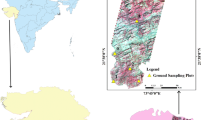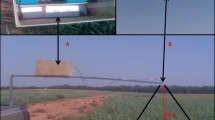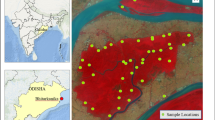Abstract
Since the typical destructive methods for measuring aboveground biomass (AGB) have many limitations, a variety of non-destructive techniques have been developed. In this paper, the potential of ground-based hyperspectral remote-sensed data for non-destructive assessment of semi-arid pasture AGB at the peak productive period was investigated. The reflectance spectrometric and AGB data were sampled at the end of the growing season (almost peak biomass) over two locations at pastures in the southern Horqin sandy land, eastern Inner Mongolia, China. All combinations (two-band and three-band) of narrow bands in the forms of simple ratio vegetation index (SRVI), normalized difference vegetation index (NDVI), soil adjusted vegetation index (SAVI) and enhanced vegetation index (EVI) were used in a linear regression analysis against AGB. The predictive performance of the stepwise multiple linear regression (SMLR) using 4 best VIs as input variables was compared with the performance of multivariate partial least squares regression (PLSR) using all reflectance bands as input variables to estimate AGB. It was observed that the relationship between AGB and single band spectral reflectance was low, while the estimation performance of the best VIs based on all available wavebands was improved considerably. In addition, the best VIs based on all available wavebands had considerably better fitting performance than those based on traditionally used wavebands for estimating AGB. In comparison to PLSR using the full individual reflectance as input variables, SMLR using the best VIs as input variables performed much better, with the maximum decrease in RMSECV of 37% and the relative mean absolute errors always below 12.5%. The study demonstrated the high potential to estimate pasture AGB, which is a proxy for pasture forage yield, at the peak productive period using a hyperspectral technique.









Similar content being viewed by others
References
Almas, L. K., Price, J. A., Workneh, F., & Rush, C. M. (2016). Quantifying economic losses associated with levels of wheat streak mosaic incidence and severity in the Texas High Plains. Crop Protection, 88, 155–160. https://doi.org/10.1016/j.cropro.2016.06.012.
Atzberger, C., Guérif, M., Baret, F., & Werner, W. (2010). Comparative analysis of three chemometric techniques for the spectroradiometric assessment of canopy chlorophyll content in winter wheat. Computers and Electronics in Agriculture, 73(2), 165–173.
Barrachina, M., Cristóbal, J., & Tulla, A. F. (2015). Estimating above-ground biomass on mountain meadows and pastures through remote sensing. International Journal of Applied Earth Observation and Geoinformation, 38, 184–192.
Boegh, E., Soegaard, H., Broge, N., Hasager, C. B., Jensen, N. O., Schelde, K., et al. (2002). Airborne multispectral data for quantifying leaf area index, nitrogen concentration, and photosynthetic efficiency in agriculture. Remote Sensing of Environment, 81(2–3), 179–193.
Boschetti, M., Bocchi, S., & Brivio, P. A. (2007). Assessment of pasture production in the Italian Alps using spectrometric and remote sensing information. Agriculture, Ecosystems & Environment, 118(1–4), 267–272.
Broge, N. H., & Leblanc, E. (2001). Comparing prediction power and stability of broadband and hyperspectral vegetation indices for estimation of green leaf area index and canopy chlorophyll density. Remote Sensing of Environment, 76(2), 156–172.
Bruno, T. J., & Svoronos, P. D. N. (2006). CRC handbook of fundamental spectroscopic correlation charts. Boca Raton: FL, USA: CRC Taylor & Francis.
Cho, M. A., Skidmore, A., Corsi, F., van Wieren, S. E., & Sobhan, I. (2007). Estimation of green grass/herb biomass from airborne hyperspectral imagery using spectral indices and partial least squares regression. International Journal of Applied Earth Observation and Geoinformation, 9(4), 414–424.
Darvishzadeh, R., Skidmore, A., Schlerf, M., Atzberger, C., Corsi, F., & Cho, M. (2008). LAI and chlorophyll estimation for a heterogeneous grassland using hyperspectral measurements. ISPRS Journal of Photogrammetry and Remote Sensing, 63(4), 409–426.
Duan, L., Liu, T., Wang, X., Wang, G., Ma, L., & Luo, Y. (2011). Spatio-temporal variations in soil moisture and physicochemical properties of a typical semiarid sand-meadow-desert landscape as influenced by land use. Hydrology and Earth System Sciences, 15(6), 1865–1877.
Fatehi, P., Damm, A., Schweiger, A. K., Schaepman, M. E., & Kneubühler, M. (2015). Mapping alpine aboveground biomass from imaging spectrometer data: A comparison of two approaches. IEEE Journal of Selected Topics in Applied Earth Observations and Remote Sensing, 8(6), 3123–3139.
Fava, F., Colombo, R., Bocchi, S., Meroni, M., Sitzia, M., Fois, N., et al. (2009). Identification of hyperspectral vegetation indices for Mediterranean pasture characterization. International Journal of Applied Earth Observation and Geoinformation, 11(4), 233–243.
Fava, F., Parolo, G., Colombo, R., Gusmeroli, F., Della Marianna, G., Monteiro, A. T., et al. (2010). Fine-scale assessment of hay meadow productivity and plant diversity in the European Alps using field spectrometric data. Agriculture, Ecosystems & Environment, 137(1–2), 151–157.
Finger, R., Lazzarotto, P., & Calanca, P. (2010). Bio-economic assessment of climate change impacts on managed grassland production. Agricultural Systems, 103(9), 666–674.
Forchetti, D. A. P., & Poppi, R. J. (2017). Use of NIR hyperspectral imaging and multivariate curve resolution (MCR) for detection and quantification of adulterants in milk powder. LWT-Food Science and Technology, 73, 337–343.
Foster, A. J., Kakani, V. G., & Mosali, J. (2017). Estimation of bioenergy crop yield and N status by hyperspectral canopy reflectance and partial least square regression. Precision Agriculture, 18(2), 192–209.
Fritz, M., & Berger, P. D. (2015). Chapter 10 - Can you relate in multiple ways? Multiple linear regression and stepwise regression. Improving the User Experience Through Practical Data Analytics (pp. 239–269). Boston, USA: Morgan Kaufmann.
Gasch, C. K., Huzurbazar, S. V., & Stahl, P. D. (2015). Small-scale spatial heterogeneity of soil properties in undisturbed and reclaimed sagebrush steppe. Soil & Tillage Research, 153, 42–47.
Geladi, P., & Kowalski, B. R. (1986). Partial least-squares regression: a tutorial. Analytica Chimica Acta, 185, 1–17.
Ghassemian, H. (2016). A review of remote sensing image fusion methods. Information Fusion, 32, 75–89.
Gnyp, M. L., Bareth, G., Li, F., Lenz-Wiedemann, V. I. S., Koppe, W., Miao, Y., et al. (2014). Development and implementation of a multiscale biomass model using hyperspectral vegetation indices for winter wheat in the North China Plain. International Journal of Applied Earth Observation and Geoinformation, 33, 232–242.
Hansen, P. M., & Schjoerring, J. K. (2003). Reflectance measurement of canopy biomass and nitrogen status in wheat crops using normalized difference vegetation indices and partial least squares regression. Remote Sensing of Environment, 86(4), 542–553.
Huete, A. R. (1988). A soil-adjusted vegetation index (SAVI). Remote Sensing of Environment, 25(3), 295–309.
Huete, A. R., Liu, H. Q., Batchily, K., & van Leeuwen, W. (1997). A comparison of vegetation indices over a global set of TM images for EOS-MODIS. Remote Sensing of Environment, 59(3), 440–451.
Jiao, C., Yu, G., He, N., Ma, A., Ge, J., & Hu, Z. (2017). Spatial pattern of grassland aboveground biomass and its environmental controls in the Eurasian steppe. Journal of Geographical Sciences, 27(1), 3–22.
Jordan, C. F. (1969). Derivation of leaf-area index from quality of light on the forest floor. Ecology, 50(4), 663–666. https://doi.org/10.2307/1936256.
Kalacska, M., Lalonde, M., & Moore, T. R. (2015). Estimation of foliar chlorophyll and nitrogen content in an ombrotrophic bog from hyperspectral data: Scaling from leaf to image. Remote Sensing of Environment, 169, 270–279.
Li, Z., Han, G., Zhao, M., Wang, J., Wang, Z., Kemp, D. R., et al. (2015). Identifying management strategies to improve sustainability and household income for herders on the desert steppe in Inner Mongolia, China. Agricultural Systems, 132, 62–72.
Li, Y., Liu, Y., Wu, S., Wang, C., Xu, A., & Pan, X. (2017). Hyper-spectral estimation of wheat biomass after alleviating of soil effects on spectra by non-negative matrix factorization. European Journal of Agronomy, 84, 58–66.
Lu, D. S. (2006). The potential and challenge of remote sensing-based biomass estimation. International Journal of Remote Sensing, 27(7), 1297–1328. https://doi.org/10.1080/01431160500486732.
Luo, S., Wang, C., Xi, X., Pan, F., Qian, M., Peng, D., et al. (2017). Retrieving aboveground biomass of wetland Phragmites australis (common reed) using a combination of airborne discrete-return LiDAR and hyperspectral data. International Journal of Applied Earth Observation and Geoinformation, 58, 107–117.
Mahajan, G. R., Pandey, R. N., Sahoo, R. N., Gupta, V. K., Datta, S. C., & Kumar, D. (2016). Monitoring nitrogen, phosphorus and sulphur in hybrid rice (Oryza sativa L.) using hyperspectral remote sensing. Precision Agriculture, 18(5), 736–761. https://doi.org/10.1007/s11119-016-9485-2.
Mutanga, O., & Skidmore, A. K. (2004). Hyperspectral band depth analysis for a better estimation of grass biomass (Cenchrus ciliaris) measured under controlled laboratory conditions. International Journal of Applied Earth Observation and Geoinformation, 5(2), 87–96.
Nogales-Bueno, J., Baca-Bocanegra, B., Jara-Palacios, M. J., Hernandez-Hierro, J. M., & Heredia, F. J. (2017). Evaluation of the influence of white grape seed extracts as copigment sources on the anthocyanin extraction from grape skins previously classified by near infrared hyperspectral tools. Food Chemistry, 221, 1685–1690.
Qiao, X. J., Jiang, J. B., Qi, X. T., Guo, H. Q., & Yuan, D. S. (2017). Utilization of spectral-spatial characteristics in shortwave infrared hyperspectral images to classify and identify fungi-contaminated peanuts. Food Chemistry, 220, 393–399.
Rouse, J. W., Haas, R. H., Schell, J. A., Deering, D. W., & Harlan, J. C. (1974). Monitoring the vernal advancement of retrogradation of natural vegetation. Greenbelt, MD, USA: NASA/GSFC.
Sweet, S. K., Asmus, A., Rich, M. E., Wingfield, J., Gough, L., & Boelman, N. T. (2014). NDVI as a predictor of canopy arthropod biomass in the Alaskan arctic tundra. Ecological Applications, 25(3), 779–790.
Tamme, R., Gazol, A., Price, J. N., Hiiesalu, I., & Pärtel, M. (2016). Co-occurring grassland species vary in their responses to fine-scale soil heterogeneity. Journal of Vegetation Science, 27(5), 1012–1022. https://doi.org/10.1111/jvs.12431.
Thenkabail, P. S., Smith, R. B., & De Pauw, E. (2000). Hyperspectral vegetation indices and their relationships with agricultural crop characteristics. Remote Sensing of Environment, 71(2), 158–182.
Tong, X., Liu, T., Singh, V. P., Duan, L., & Long, D. (2016). Development of in situ experiments for evaluation of anisotropic reflectance effect on spectral mixture analysis for vegetation cover. IEEE Geoscience and Remote Sensing Letters, 13(5), 636–640.
Yue, J., Feng, H., Yang, G., & Li, Z. (2018). A comparison of regression techniques for estimation of above-ground winter wheat biomass using near-surface spectroscopy. Remote Sensing, 10(1), 66. https://doi.org/10.3390/rs10010066.
Zandler, H., Brenning, A., & Samimi, C. (2015). Potential of space-borne hyperspectral data for biomass quantification in an arid environment: advantages and limitations. Remote Sensing, 7(4), 4565–4580.
Zhao, D., Reddy, K. R., Kakani, V. G., Read, J. J., & Koti, S. (2007). Canopy reflectance in cotton for growth assessment and lint yield prediction. European Journal of Agronomy, 26(3), 335–344.
Acknowledgements
The authors would like to thank Jiaozhuan Yao and Tenghe for the help in collecting in situ data. The field and laboratory support of Xiaoyan Gao is greatly appreciated. This work was financially supported by the National Natural Science Foundation of China [Grant Nos 51620105003, 51139002, 51479086 and 51369016], the Ministry of Education Innovative Research Team [Grant Number IRT_13069], the Innovation Team in Priority Areas Accredited by the Ministry of Science and Technology [Grant Number 2015RA4013], and the Inner Mongolia Grassland Elite Innovative Research Team (2012).
Author information
Authors and Affiliations
Corresponding author
Rights and permissions
About this article
Cite this article
Tong, X., Duan, L., Liu, T. et al. Combined use of in situ hyperspectral vegetation indices for estimating pasture biomass at peak productive period for harvest decision. Precision Agric 20, 477–495 (2019). https://doi.org/10.1007/s11119-018-9592-3
Received:
Accepted:
Published:
Issue Date:
DOI: https://doi.org/10.1007/s11119-018-9592-3




